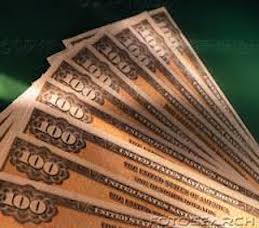Savings bonds are sold in two varieties, I bonds and EE bonds. EE bonds pay a fixed rate of interest until maturity (20 years after issue) and then are guaranteed to double in value. I Bonds pay a fluctuating rate of interest which is tied to inflation. Or, to be more precise, I Bonds have a fixed component which remains constant through the life of the bond and a floating component that tracks the Consumer Price Index (CPI-U).
On November 1st, 2013 the Treasury Department Announced the rates for newly purchased saving bonds. These rates are applicable for savings bonds purchased from November 1 st, 2013 through April 30th, 2014
|
Fixed Interest Rate Component |
Inflation Interest Rate Component |
Total Annualized Interest Rate |
|
|
EE Bonds |
0.1% |
——————— |
0.1% |
|
I Bonds |
0.2% |
1.18% (changes every six months) |
1.38% |
These rates are very unusual. (Historical Rate Table) Never before has the fixed rate component of a newly issued I Bond been higher than the entire interest on a newly issued EE-bond. It almost defies logic.
Why would a person buy an EE bond instead of an I Bond?
-
The I Bond Pays A Higher Fixed Interest
-
The I Bond Pays The Rate Of Inflation (which historically averages 2% per year)
I am convinced that I Bonds currently represent a much better buy than EE bonds but . .
There are two possible arguments that could be made for buying EE bonds instead of I Bonds. If inflation is negative, the I Bond could pay zero percent interest in subsequent 6 month periods of time after purchase. When CPI-U is negative, CPI-U is deducted from the fixed component to calculate the total interest rate for I Bonds, with a floor of zero percent. It’s a remote possibility that in the future, the total interest rate on I bonds could be 0.0%. For EE bonds to be the better buy, inflation would have to be negative for a decade if not longer.
The other argument is more plausible. When held until maturity (20 years), EE bonds pay an effective interest rate of around 3.5%. Thus, if you absolutely are sure that you will not need the funds for 20 years, you’re better off buying an EE bonds (assuming the average inflation rate is less than 3.3% during that period time).
An Alternative To Savings Bonds – 5 Year CDs
If your time horizon is shorter than 20 years, CDs may be a better potential investment than either I or EE Saving bonds. If you got Learn Bond’s CD rates page, you can find several 5 year CDs that pay around 2% interest.
Trusted & Regulated Stock & CFD Brokers
What we like
- 0% Fees on Stocks
- 5000+ Stocks, ETFs and other Markets
- Accepts Paypal Deposits
Min Deposit
$200
Charge per Trade
Zero Commission on real stocks
64 traders signed up today
Visit Now67% of retail investor accounts lose money when trading CFDs with this provider. You should consider whether you can afford to take the high risk of losing your money.
Available Assets
- Total Number of Stocks & Shares5000+
- US Stocks
- German Stocks
- UK Stocks
- European
- ETF Stocks
- IPO
- Funds
- Bonds
- Options
- Futures
- CFDs
- Crypto
Charge per Trade
- FTSE 100 Zero Commission
- NASDAQ Zero Commission
- DAX Zero Commission
- Facebook Zero Commission
- Alphabet Zero Commission
- Tesla Zero Commission
- Apple Zero Commission
- Microsoft Zero Commission
Deposit Method
- Wire Transfer
- Credit Cards
- Bank Account
- Paypall
- Skrill
- Neteller
What we like
- Sign up today and get $5 free
- Fractals Available
- Paypal Available
Min Deposit
$0
Charge per Trade
$1 to $9 PCM
Visit Now
Investing in financial markets carries risk, you have the potential to lose your total investment.
Available Assets
- Total Number of Shares999
- US Stocks
- German Stocks
- UK Stocks
- European Stocks
- EFTs
- IPOs
- Funds
- Bonds
- Options
- Futures
- CFDs
- Crypto
Charge per Trade
- FTSE 100 $1 - $9 per month
- NASDAQ $1 - $9 per month
- DAX $1 - $9 per month
- Facebook $1 - $9 per month
- Alphabet $1 - $9 per month
- Telsa $1 - $9 per month
- Apple $1 - $9 per month
- Microsoft $1 - $9 per month
Deposit Method
- Wire Transfer
- Credit Cards
- Bank Account



